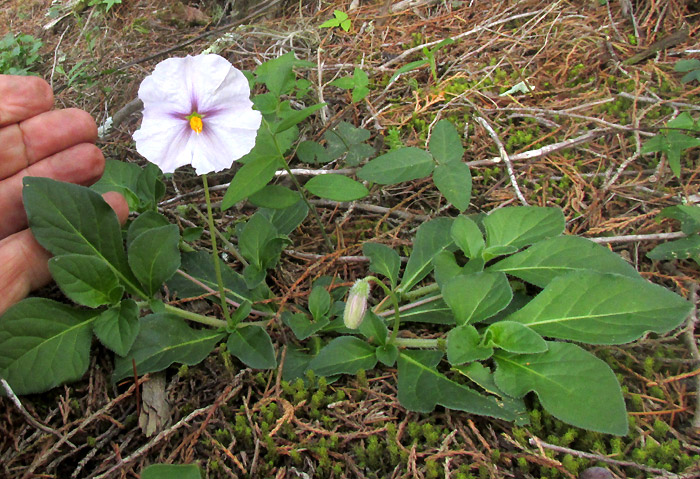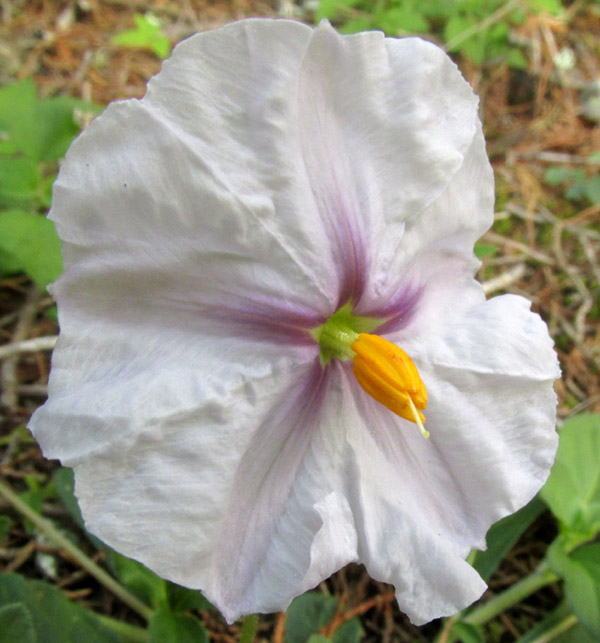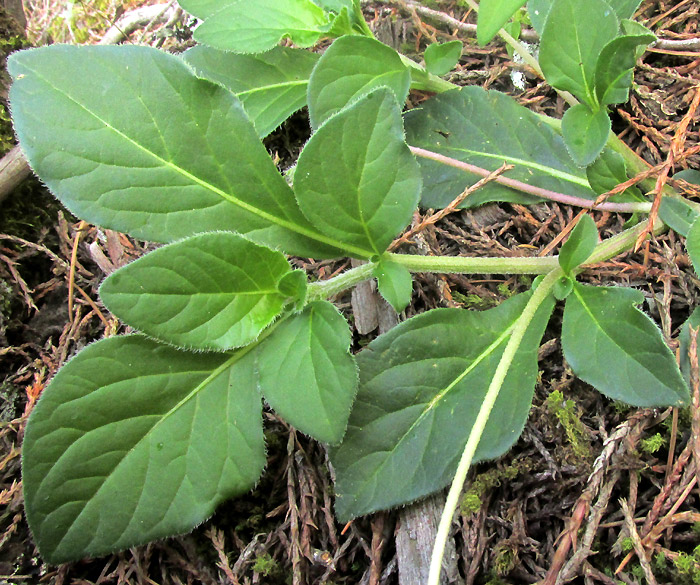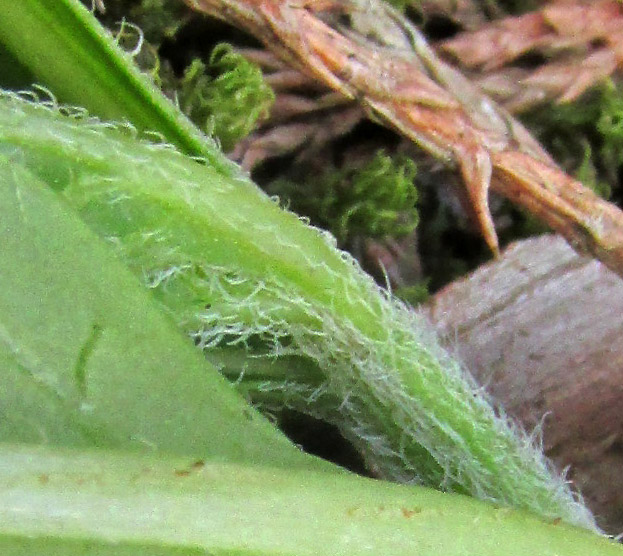Excerpts from Jim Conrad's
Naturalist Newsletter
Entry from field notes dated August 31, 2023, taken in Los Mármoles National Park, Hidalgo state, MÉXICO, along steeply climbing road heading eastward out of town of Trancas {on maps designated "Morelos (Trancas)"} toward Nicolás Flores; juniper/pine/oak forest on limestone bedrock; elevation ~2,200m (~7,200ft); (~N20.801°, ~W99.254°)
LYCIANTHES PEDUNCULARIS

The above wildflower grew alone on a steep, usually shaded slope encrusted with mosses, atop which lay a carpet of fallen juniper branches and twigs. Even at a distance, with its widely flaring, roundish or "rotate" corolla, and with a conspicuously yellow, nose-like set of five pollen-producing anthers, the plant clearly was a member of the big Nightshade Family, of tomato, potato and petunia fame, the Solanaceae. A feature setting this plant apart from other similar-looking members of this family was that its stems ran along the ground's surface. This adaptation often is seen in species occurring where grazing animals might find it easier to feed on them if they developed erect stems. Cattle freely roamed these particular slopes, even fairly steep ones.

Closer up, the blossoms with their five stamens with banana-like anthers looked like typical nightshade flowers, genus Solanum. Nightshade flowers often are pale purplish like this, too. However, behind the corolla, the calyx told a different story:

Instead of a simple five-lobed calyx, there were ten slender, fingerlike appendages. These announced the genus Lycianthes, species of which in English usually are referred to as Lycianthes. According to the 2020 work of Ellen Dean and others entitled "The genus Lycianthes (Solanaceae, Capsiceae) in Mexico and Guatemala,"Lycianthes is the third most species-rich genus in the Nightshade Family, occurring in both the New and Old Worlds, but especially diverse in Mexico, where 53 Lycianthes species are known. Here in upland central Mexico we've already met Lycianthes moziniana, which stood upright and bore much narrower leaves, and Lycianthes dejecta, with lower anthers extending much farther out than the upper ones, and calyx hairs much shorter and looking mealy in comparison to our present species' long, slender hairs not at all giving an impression of mealiness. This was a new-for-us Lycianthes. Here's a better look at the reclining stems and broad, simple leaves:

For Lycianthes identification to species level, the nature of the plant's hairs is important. Below it's seen that this species' hairs are long, white, slender, non-branching, and not mixed with branched hairs:

The above features, particularly our plant's prostrate stems and the slender, simple hairs not mixed with branched hairs, lead to LYCIANTHES PEDUNCULARIS. This species is endemic just to upland central Mexico, distributed in two populations separated from one another by the east-west aligned Trans-Mexican Volcanic Belt. The southern population occurs in the states of Oaxaca, Puebla and México; our northern population appears in Guanajuato, Querétaro, and here in Hidalgo. Both populations predominantly live atop limestone bedrock, while the Volcanic Belt provides a mainly igneous substrate. One can speculate that before the Volcanic Belt arose in its present configuration during the Middle Miocene some 12 million years ago, the distribution of Lycianthes peduncularis may have been continuous, coinciding with a region of unbroken limestone bedrock.
Lycianthes peduncularis is described as mainly living in dry scrub habitats and only rarely in pine/juniper woodland such as here. Often the species is found on slopes of canyons or other drainage features, as well as in upland fields and pastures. Within its small distribution area it's considered as not really common, but not threatened, either, because of its occurrence in disturbed or eroded situations, of which upland central Mexico offers plenty.
In traditional Mexican society the various Lycianthes species may not be distinguished from one another, plus they may be thought of as not differing from Solanum species. In fact, the taxonomy of this branch of the Nightshade Family is not well understood, and the genera are so similar that some authorities suspect that several Solanum species may need to be reassigned to Lycianthes.
Though Solanum is recognized as producing chemical compounds that may be toxic or medicinal, depending on their application, relatively few studies have been done on Lycianthes species. However, in the 2022 study by Abdalla Ali Amin and others entitled "Antioxidant properties of Lycianthes rantonnetii and contents of vitamin and element," a South American Lycianthes species was analyzed. The authors found that since "... the content of antioxidant vitamins, minerals of the L. rantonnetii plant was at high levels and it contains a reasonable amount of total phenol, and flavonoids also, it was determined that the plant had a high scavenging activity for free radicals." Thus it seemed that this Lycianthes could be used as a food additive to produce "appropriate antioxidant activities," and by extension maybe other Lycianthes species could be therapeutic as well.